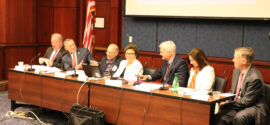Employers Must Embrace Viral Testing, Not Temperature Screening
A new article in the National Review by Dr. David Shaywitz examines what works when it comes to testing for COVID-19.
By David Shaywitz
National Review
June 29, 2020
Few trends better highlight our desperate need for reassurance than the nearly universal installation of temperature checks in ever more workplace environments. The approach is quick, easy, cheap, and occasionally high-tech, in
some cases generating futuristic thermal images that resemble something from Predator.
There’s just one problem: The approach doesn’t really work.
As Dr. Rajaie Batniji, a Stanford physician and co-founder of Collective Health, which focuses on employer health benefits, recently wrote:
“Temperature screening provides false assurance to employees entering the workplace. One recent study showed that about 70% of patients sick enough to be hospitalized for Covid-19 did not have fevers. Coupled with the fact that most people infected with the coronavirus do not have symptoms, screening for temperatures will miss at least 86% of infected individuals, and likely miss an even higher percentage.
A ‘barrier’ that allows nearly 9 in 10 infected individuals to enter a workplace or business is not one that should be used to provide reassurance to employees.”
Yet temperature screening seems to be just what many employees are requesting, in order to feel more secure in their workplace. When a large healthcare company recently surveyed its workers about what would make them comfortable to return to work, the No.1 item was the institution of daily temperature checks.
In other words, temperature checks seem to function essentially as placebos, helping the users feel better, but not actually doing much good, and potentially making things worse by conveying a false sense of security to workers.
The best approach, not surprisingly, is testing for the virus itself — basically what the White House seems to be doing on a daily basis. This approach, Batniji estimates, has just a 2 percent chance of missing infected workers. The catch, of course, is the cost, especially when you think about how frequently one might need to test; ideally, as Batniji suggests, this would be “based on local epidemiology of COVID-19, personal and workplace risk factors.” By “tracking symptoms and contacts, employers can calibrate how often they need to test workers to greatly reduce the risk of workplace transmission.”
The use of “pooled testing” is another approach apparently under active consideration by the Administration, according to recent comments by Anthony Fauci; this scheme aims to balance the benefits of virus testing with the costs by testing samples in batches (say 20 or 25 at a time), and then only doing individual tests on those in a positive pool.
America is eager to return to work, to school, to life — but we remain concerned about the very real risk of the virus, as both opinion polls and recent case spikes have reminded us. Wishing the virus away has not proved a viable approach either. Relying on temperature screening isn’t much better. The enemy here isn’t the perception of a pandemic — it’s the reality of one.
If we’re to durably achieve an economic recovery, employers will need to embrace –and employees demand — authentic solutions, like viral testing, rather than deceptive, feel-good measures, like temperature checks.
DAVID SHAYWITZ, a physician-scientist and the founder of Astounding HealthTech, a Silicon Valley advisory service, is an adjunct scholar at the American Enterprise Institute and a lecturer in the Department of Biomedical Informatics at Harvard Medical School.
Related

Congressional Dyslexia Roundtable
Excited, we have unusually positive news to share about science, dyslexia and legislation. Far too often there is …
Read MoreUpdate on the Connecticut Longitudinal Study (CLS)
Much of this new scientific understanding of dyslexia has emerged from a longitudinal study, the Connecticut Longitudinal Study …
Read MoreCoursera: Exciting New Online Dyslexia Course
A very exciting announcement that positively impacts children with dyslexia, their parents and their teachers is the Dyslexia …
Read MoreWho will be the first civilian in space? A dyslexic of course—Sir Richard Branson.
Who will be the first civilian in space? A dyslexic of course—Sir Richard Branson. On Sunday, Sir Richard …
Read More